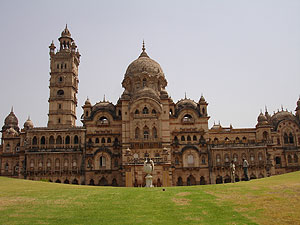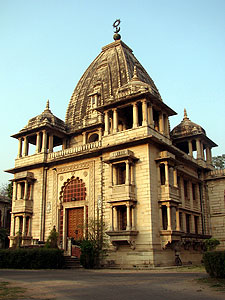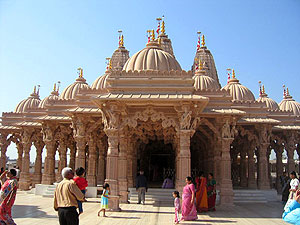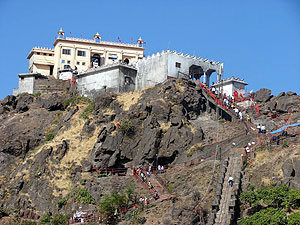|
Vadodara Attractions |
|
|
|
|
|
The main tourist
attractions in Vadodara are the Laxmi Vilas Palace, Naulakhi
Well, Maharaja Fateh Singh Museum and Nazar Bagh Palace.
|
|
|
|
Laxmi
Vilas Palace
The Laxmi Vilas Palace was built by R.H. Chisholm.
This palace was built in full throttle 19th century
Indo-Saracenic style for Rs.6 million. The after early
designs by the military engineer Mant, the facade of
this extraordinary building is 150 m wide. The palace
is faced in red Agra sandstone with dressings of blue
trapstone from Pune and Rajasthani marble. The
approach to the palace is very pleasant and the
interior is spectacular. The Durbar Hall has walls and
floor in Venetian mosaic and marble is used
extensively throughout, as is stained glass from
London.
Maharaja Fateh
Singh Museum |
 |
|
|
The Maharaja Fateh Singh Museum contains some
fine European paintings.
Tambekar
Wada
The Tambekar Wada is a wooden multistoreyed townhouse. This
typical Maratha mansion was once the residence of Bhau
Tambekar, Diwan of Baroda. Inside are some beautiful 19th
century murals. |
|
|
|
Kirti
Mandir
The Kirti Mandir is situated around the Sursagar Lake
in the centre of the town. The Kirti Mandir houses the
Gaekwad Samadhi or memorial ground.
Sayaji Bagh
Within this shady, pleasant park is the Baroda Museum,
which houses some good Asian statues and carvings,
mangy zoology exhibits and an Egyptian room. The
gallery has lovely Mughal miniatures and a motley crew
of European masters.
Nazar Bagh Palace
The Nazar Bagh Palace has a Sheesh Mahal (Mirror
Palace), a collection of the embroidered cloth and the
jewel 'Star of the south'. The solid gold and silver
guns, each barrel 127 kgs. in weight were kept here
which on ceremonial occasions, were drawn by the teams
of milk-white bullocks.
Makarpura Palace |
 |
|
|
Makarpura Palace is
situated about 7 kms. to the south of the city. This was
built in an Italian Renaissance style and has a facade of
three storeys each with an arcade running around beautiful
gardens.
Naulakhi Well
The Naulakhi Well is a fine baoli, about 50 kms. to the
north of the palace. It is a well preserved baoli (step
well) which has galleried compartments or levels.
Excursions from
Vadodara |
|
|
|
Bharuch
Bharuch appeared in the historical records nearly 200
years ago. It is on the main rail line between
Vadodara and Surat, about an hour from each. It is one
of the oldest seaports in western India and flourished
in the 1st century AD. Under the name of Barugaza, the
town was mentioned by the Romans in 210 AD. It was
ruled by the Gurhara Prince and much later came under
the rule of the Solanki Rajputs. The Bhrigu Rishi
Temple from which the town got its name (Bhrigukachba,
later shortened to Bharuch) is on the banks of the
Narmada river. It subsequently developed at the lowest
crossing of the river, a point of strategic
importance. The hilltop fort |
 |
|
|
overlooks the wide Narmada
river and has the Jama Masjid at its base. The Jama Masjid
was built from a demolished Jain temple but in accordance
with conventional mosque design. Just over 3 kms. west of
the fort are some early Dutch tombs, overlooked by some
Parsee Towers of Silence. |
|
|
|
Pavagadh
the word Pavagadh means a quarter of the hill and was
believed to have been part of the Himalaya carried off
by the monkey god Hanuman. The Pavagadh Fort is
situated 4 kms. southwest of the city. The Pavagadh
fort dominates the syline and is visible for miles
around. It occupies a large area and rises in three
stages: first the ruined fort, then the palace and
middle fort and finally the upper fort with Jain and
Hindu temples. The parts of the massive walls still
stand. The ascent is steep and passes several ruins
including the Buria Darwaza, the Champavati Mahal, a
three storey summer pavilion. The temple at the summit
had its spires removed by |
 |
|
|
the Muslims and a shrine of Sadan Shah, a
Muslim saint.
|